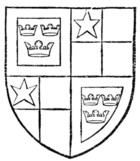of Hitcham, Bucks, who bear: "On a sinister canton azure, a demi-ram salient of the first, and in chief two fleurs-de-lis or, debruised by a baton," to commemorate the action of Sir John Clerke of Weston, who captured Louis D'Orleans, Duke of Longueville, at Borny, near Terouenne, 5 Henry VII. The augmentation conferred upon the Duke of Norfolk at the battle of Flodden has been already referred to, but the family of Lloyd of Stockton, co. Salop, carry a remarkable augmentation, inasmuch as they are permitted to bear the arms of Sir John Oldcastle, Lord Cobham, to commemorate his recapture by their ancestor after Lord Cobham's escape from the Tower.

Fig. 773.—Arms of Robert de Vere, Duke of Ireland and Earl of Oxford: Quarterly, 1 and 4 (of augmentation), azure, three crowns or, within a bordure argent; 2 and 3, quarterly gules and or, in the first quarter a mullet argent.
Augmentations which have no other basis than mere favour of kings, or consanguinity to the Royal Family, are not uncommon. Richard II., who himself adopted the arms of St. Edward the Confessor, bestowed the right to bear them also upon Thomas Mowbray, Duke of Norfolk (Fig. 675). No difference was added to them in his case, which is the more remarkable as they were borne by the Duke impaled with the arms of England. In 1397 the King conferred the same arms upon John de Holland, Duke of Exeter, differenced by a label argent, and upon Thomas de Holland, Duke of Surrey, within a bordure ermine. Richard II. seems to have been inclined to the granting of augmentations, for in 1386, when he created the Earl of Oxford (Robert de Vere) Duke of Ireland, he granted him as an augmentation the arms of Ireland ("Azure, three crowns or") within a bordure argent (Fig. 773). The Manners family, who were of Royal descent, but who, not being descended from an heiress, had no right to quarter the Royal Arms, received the grant of a chief "quarterly azure and gules, in the first and fourth quarters two fleurs-de-lis, and in the second and third a lion passant guardant or." This precedent might well be followed at the present day in the case of the daughters of the Duke and Duchess of Fife. It was adopted in the case of Queen Victoria Eugenie of Spain. The Waller family, of Groombridge, co. Kent, one of whom, Richard Waller, captured Charles, Duke of Orleans, at the battle of Agincourt, received as an augmentation the right to suspend from the crest ("On a mount a walnut-tree proper") an escutcheon of the arms of that Prince, viz.: "Azure, three fleurs-de-lis or, a label of three points argent." Lord Polwarth bears one of the few augmentations granted by William III., viz.: "An inescutcheon azure charged with an orange ensigned with an Imperial crown
